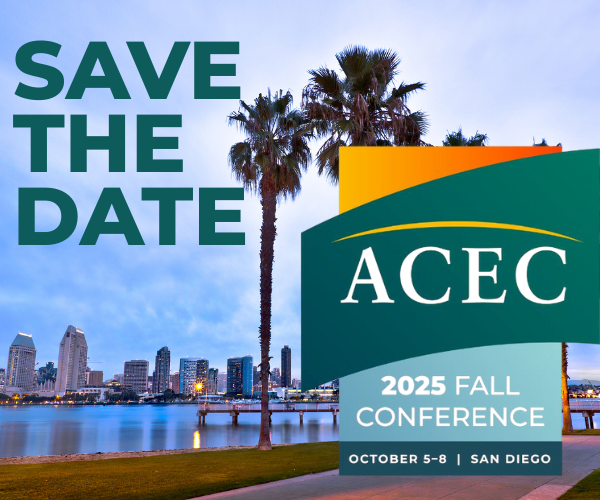ACEC News / Advocacy
September 15, 2021
ACEC Advocacy Team Summarizes Key Proposed Investment and Tax Changes in Reconciliation Bill
House committees are drafting their pieces of the social spending and tax package that will be considered by Congress under the budget reconciliation process.
Below is a summary of key provisions of interest to the engineering industry as of Monday, September 13, 2021. These may change prior to consideration by the full House at the end of September, and it is likely that the Senate will put forward its own provisions before a compromise between the two bodies can be reached later this fall.
Transportation
Affordable Housing Access Program: $10 billion to support access to affordable housing and enhance mobility (e.g. public transit) for low-income individuals and residents of disadvantaged communities.
Community Climate Incentive Grants: $4 billion to reduce surface transportation-related greenhouse gas emissions, including $950 million for incentive grants to states that make significant progress in reducing emissions or that adopt strategies to achieve net-zero surface transportation emissions by 2050, and $3 billion for non-state entities for projects to reduce carbon emissions.
Neighborhood Access and Equity Grants: $4 billion to support neighborhood equity, safety, and affordable transportation access, including competitive grants to reconnect communities divided by existing infrastructure barriers, mitigate negative impacts of transportation facilities or construction projects on disadvantaged or underserved communities, and to support equitable transportation planning and community engagement activities.
Passenger Rail Improvement, Modernization, and Emissions Reduction Grants: $10 billion for high-speed rail corridor assistance for the planning and development of public high-speed rail projects.
Port Infrastructure and Supply Chain Resilience: $2.5 billion for grants for projects to support supply chain resilience, reduction in port congestion, the development of offshore wind support infrastructure, environmental remediation, and projects to reduce the impact of ports on the environment.
Local Transportation Priorities: $6 billion to advance local surface transportation projects (i.e. House designated earmarks that were included in the INVEST Act but left out of the Senate infrastructure bill).
Click here for the full section-by-section summary from the House Transportation Committee.
Buildings
Assistance for Federal Buildings: $1 billion for the General Services Administration’s Federal Buildings Fund to convert GSA owned or managed buildings to high-performance green buildings.
FEMA programs: $300 million for grants to state, local, tribal, and territorial governments for implementation and enforcement activities of the latest published editions of relevant performance-based and consensus-based codes, specifications, and standards that incorporate hazard-resistant designs and the latest requirements for the maintenance and inspection of existing buildings to address hazard risk; plus an additional $500 million to the FEMA hazard mitigation revolving loan fund program.
Veterans Administration: $15 billion for VA infrastructure, taking into consideration the integration of resiliency into infrastructure as well as the needs of underserved veteran populations.
Public schools: $82 billion for public school districts to repair, modernize, and rebuild school buildings.
Drinking Water and Wastewater
Sewer Overflow and Stormwater Reuse Municipal Grants: $2 billion to invest in sewer overflow and stormwater reuse projects.
Lead Service Line Replacement: $30 billion for lead service line replacement projects.
Community Water System Risk and Resilience: $500 million for grants to community water systems to improve resilience.
Environmental Clean Up
Superfund Investments: $10 billion for response actions to be carried out by responsible federal agencies at federal facilities on the National Priority List pursuant to the Comprehensive Environmental Response, Compensation, and Liability Act.
Energy
Clean Electricity Performance Program: $150 billion in a Clean Electricity Performance Program (CEPP) at the Department of Energy (DOE) to issue grants to and collect payments from electricity suppliers from 2023 through 2030 based on how much qualified clean electricity each supplier provides to customers.
Electric Vehicles: $13.5 billion in electric vehicle infrastructure to support development of an electric vehicle charging network to assist the transition to zero emissions vehicles. This funding will go toward construction of charging infrastructure in publicly accessible locations.
Energy Innovation: $7 billion in multiple loan and grant programs at DOE to support development of zero emission transportation technologies.
Electricity Transmission: $9 billion in grants to assist states with siting transmission projects, fund DOE’s transmission planning and modeling capabilities, and provide grants and loans for constructing and modernizing grid infrastructure across the seams between the Eastern and Western Interconnections, the domestic interties with the Electric Reliability Council of Texas, and for offshore wind projects.
Gas Reduction Fund: $27.5 billion for nonprofit, state, and local climate finance institutions that support the rapid deployment of low- and zero-emission technologies. At least 40 percent of investments will be made in low income and disadvantaged communities.
Methane Fee: Establishes a methane fee on pollution from the oil and gas industry above specific intensity thresholds.
Click here for a full section-by-section summary from the House Energy & Commerce Committee.
Rural Development and Forestry
Rural infrastructure: $7.75 billion in investments in agricultural research and infrastructure. Provides funding for more than $18 billion in investments to help rural communities modernize energy and water systems and provides funding to support clean fuels.
Forestry resources: $40 billion in forestry programs to ensure public and private lands can address the destructive fire seasons, restore forest ecosystems, improve watershed health, and enhance wildlife habitat; includes $14 billion dollars for hazardous fuels treatments across the National Forest System and adjacent lands and $9 billion in forest restoration and wildfire resilience grants for non-federal lands.
Click here for a summary from the House Agriculture Committee.
Workforce (Ways & Means Committee section-by-section summary)
Paid FMLA: The bill would create a new program, starting in July 2023, where employees could apply to Treasury for up to 12 weeks of paid leave for parental, serious illness or caregiving needs.
Retirement savings: Requires employers with 5 or more employees to maintain or facilitate a retirement savings plan that incorporates automatic contributions (i.e. employees must opt out instead of opt in). Elective deferrals must be at least 6% in the first year. Employers that do not comply will face an excise tax.
Infrastructure and green energy tax (Ways & Means section-by-section summary)
Infrastructure bonds: Issuers of qualified infrastructure bonds would receive a tax credit equal to an applicable percentage of the interest, providing direct financing support for infrastructure investments made by state and local governments.
Advance refunding bonds: This provision would allow interest on advance refunding bonds to be exempt from tax, which was repealed by the 2017 tax reform law.
Water and sewer facility bonds: This provision exempts from the private activity bond volume cap exempt facility bonds for existing water and sewage facilities as of July 1, 2020.
Production tax credit for renewables: The full PTC is extended for most facilities (e.g. wind, solar, geothermal, hydropower) through 2031 and phased out by 2034.
Investment tax credit: Extended for solar, geothermal, and other property, and extended to new property such as energy storage technology.
Section 179D: Increases the maximum deduction, modifies the ASHRAE requirement to a reduction of 25% in energy costs, provides an alternative deduction for retrofits, and allows non-profit entities to allocate the deduction to the designer.
Superfund: Reinstates Superfund taxes on crude oil, petroleum products, and chemicals through 2031.
Corporate/passthrough tax (Ways & Means section-by-section summary)
Corporate tax rate: Increase in the rate from 21% to 26.5% for corporations with revenues over $10 million. Graduated rate available to smaller corporations except personal service corporations.
International tax: Increase in the GILTI, FDII and BEAT rates. Change in the GILTI calculation from a globally blended regime to a country-by-country calculation.
Top individual rate: Increase in the top marginal rate from 37% to 39.6% for individual taxpayers with income over $400,000 and married filing jointly (MFJ) with income over $450,000.
Capital gains rate: increase in the capital gains rate from 20% to 25% for high-income taxpayers (based on the draft legislative text this appears to mean taxpayers with income over $400,000 (individual)/$450,000 (MFJ)). The 3.8% net investment income tax (NIIT) from the Affordable Care Act still applies, for a combined new rate of 28.8%.
NIIT: Applies the NIIT to business investment income for taxpayers with income over $400,000 (individual)/$500,000 (MFJ). This tax would not be assessed on wages where FICA applies.
Section 199A: Limits the passthrough deduction to $400,000 for individual taxpayers and $500,000 on a joint return (note: this is the amount of the Section 199A deduction, not an income threshold).
Surcharge on high-income individuals: New 3% tax on taxpayers with income over $5,000,000.
R&D amortization: Delays the effective date until 2026 of the R&D amortization provision from the 2017 tax reform law.
All comments to blog posts will be moderated by ACEC staff.







